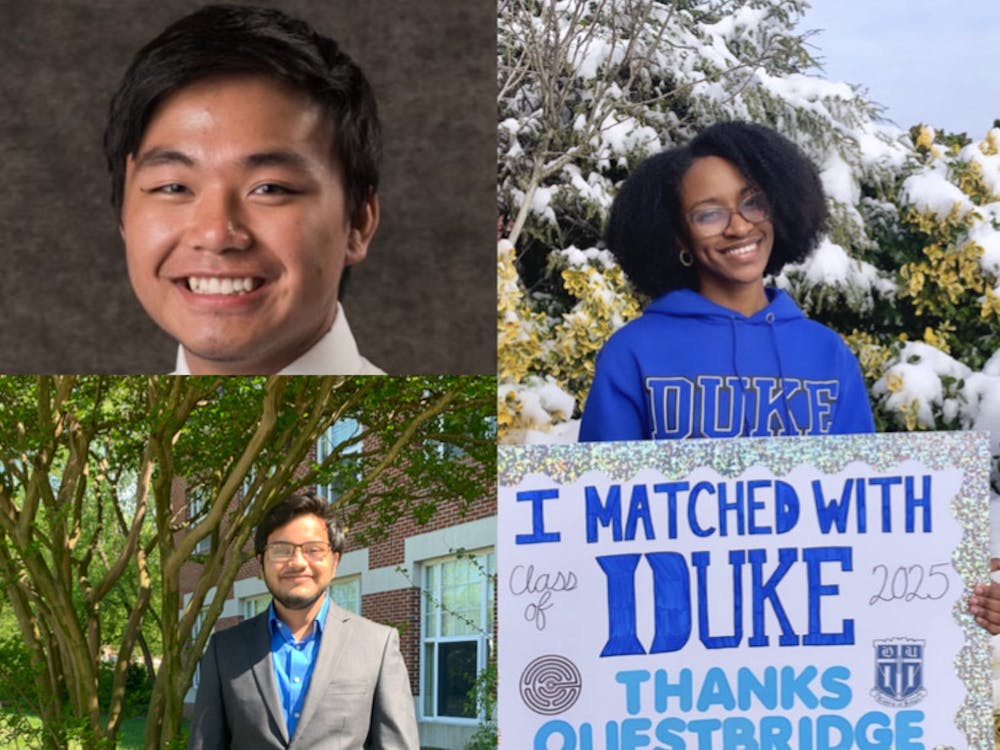When sophomore Gene Yang first arrived at Duke, he was worried that being from a low-income background would hinder his ability to find friends.
“Am I going to be hanging out with people? Doing the same things that they do, given how much money I can spend?” said Yang, who is double majoring in biology and computer science. “I had to get used to being at Duke. I went in with some stress, etcetera, concerning ‘How am I going to fit in here?’”
But Yang is a QuestBridge Scholar, and he ended up meeting his best friend through the QuestBridge program: sophomore Adan Hernandez, who is pursuing a mechanical engineering degree.
After connecting over GroupMe, the two found that they shared a love for the outdoors, watching anime and playing poker. Now, they room together on West Campus.
“QuestBridge made me realize how much great diversity there is here,” Yang said. “In terms of wealth, racial backgrounds, cultural backgrounds—it just let me start out with a support system there.”
QuestBridge is a non-profit organization that provides financial aid to exceptional low-income students, giving them the opportunity to attend the nation’s top universities despite their financial circumstances. Duke partnered with QuestBridge in 2017 and admits over 30 scholars per year.
High school students qualify for the QuestBridge scholarship if their annual household income is below $65,000. Duke has a median parent income of $186,700, with only 1.6% of students coming from low income families. According to The New York Times, 19% of students come from the top one percent of families in terms of income and just 3.9% come from the bottom 20%.
The overwhelmingly wealthy nature of Duke's student body can leave low-income students feeling out of place. But the QuestBridge Scholars community on campus provides a space where scholars can share their concerns and experiences with each other.
“If I’m like, ‘Ooh child, look at my bank account!’ I know that someone can resonate with that when I’m in the group of QuestBridge students,” said Brianna Johnson, a first-year planning on co-majoring in public policy and global health.
Johnson met her two best friends through the program, and they often spend time studying together, watching movies or baking cookies.
Inspiring community leaders
Many of the students who receive the QuestBridge Scholarship see this as their chance to eventually give back to their families and communities.
Johnson participated in public health research internships throughout high school. She was interested in food deserts from an Advanced Placement Human Geography class she took.
"From there, my interests grew,” Johnson said.
Johnson plans to pursue a career in law, hoping to make real-world changes to help members of disenfranchised communities. Beyond academics, Johnson’s heavy involvement in the Mary Lou Williams Center for Black Culture, Black Student Alliance and Black Women Union all are avenues to uplift the Black community and advocate for racial equity.
Hernandez is pursuing a degree in mechanical engineering. He’s also the secretary for the Society of Hispanic Engineers, looking to empower the Hispanic community and inspire a world of industry leaders from Latinx backgrounds.
“It gives you a little sense of responsibility because you’re representative,” Hernandez said of his motivation for community leadership.
It can be easy to dream, but Johnson knows she also needs to stay focused on the present.
“I’m really trying to adjust to this new lifestyle. Just trying to make sure that I keep my grades first,” Johnson said.
A strange process
The QuestBridge application process is different from what most high-school college applicants remember from their Common or Coalition Applications.
The prospective college student must first apply to become a QuestBridge Match finalist. The application contains several intense elimination rounds, and becoming a finalist is itself a massive achievement. In 2020, over 18,000 students applied to receive a QuestBridge Scholarship, but only 1,464 scholarships were awarded in the end.
The program is so selective that even current match scholarship recipients on Duke’s campus have been rejected before.
“They have a program for juniors, and I didn’t get into that program. So originally, I was like, ‘I’m not going to apply for the match,’” Johnson said. “But my mentor back home, he was like, ‘It doesn't hurt to apply.’”
Once a student becomes a finalist, their college application process begins. Rather than applying to schools individually, QuestBridge students write several essays shared amongst all of their schools, and admission is based on a ranked-choice list of the applicant’s preference.
However, there is a catch: QuestBridge Scholars may only attend the highest-ranked school on their list that admits them without knowing whether or not they were accepted into any of their other options.
“It gets even more confusing because there’s a good chance you’re not matched to any of those colleges on your list,” Hernandez said.
Crossing the finish line is a tumultuous process, but Johnson said her community provided support.
“I had a lot of self-doubt, but my family and friends encouraged me along the way,” Johnson said. “I just think everyone should be proud of themselves, regardless of how they got here. It’s time to elevate and move on.”
Editor's note: Brianna Johnson's discussion of her public health research internships in high school was edited to more accurately provide context for the reasons she participated in these internships.
Get The Chronicle straight to your inbox
Signup for our weekly newsletter. Cancel at any time.
James Cruikshank is a Trinity first-year and a staff reporter for the news department.

